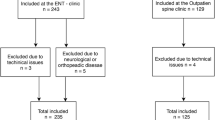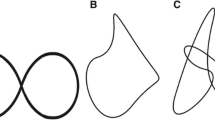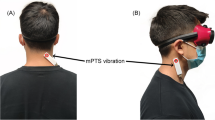Abstract
Aims: Previous studies have shown that Cervical myofascial pain syndrome with dizziness (CMPS-D ) is one of the most common causes of cervicogenic dizziness and is associated with challenge in diagnosis and treatment. this study aimed to investigate the Romberg neck torsion test in patients with CMPS-D and healthy controls. Materials and methods: Cross-sectional, observational study. twenty patients with CMPS-D were compared with twenty healthy controls. the Romberg (neutral position and neck torsion) and smooth pursuit neck torsion tests were performed in patients with CMPS-D and healthy controls. Results: The results confirmed that there are significant differences in the Romberg neck torsion test between subjects with CMPS-D and healthy controls (p < 0.05). in addition, There was a significant correlation between Romberg neck torsion and smooth pursuit neck torsion results (p < 0.05). Conclusion: The results of Romberg neck torsion test in CMPS-D subjects were different from those in healthy controls, which was attributed to neck pain and changes in cervical proprioception input. Romberg neck torsion is a new method for assessing cervicogenic dizziness.




Similar content being viewed by others
References
Yacovino DA, Hain TC (eds) (2013) Clinical characteristics of cervicogenic-related dizziness and vertigo. Seminars in neurology. Thieme Medical Publishers
Brandt T, Bronstein A (2001) Cervical vertigo. J Neurol Neurosurg Psychiatry 71(1):8–12
Mukhopadyay KK, Raman R (2021) Cervical vertigo: a brief review. Int J Orthop Surg 29(1):16
Wright EF (2000) Referred craniofacial pain patterns in patients with temporomandibular disorder. J Am Dent Association 131(9):1307–1315
Sahin N, Karataş O, Ozkaya M, Çakmak A, Berker E (2008) Demographics features, clinical findings and functional status in a group of subjects with cervical myofascial pain syndrome. Agri: Agri (Algoloji) Dernegi’nin Yayin organidir = the. J Turkish Soc Algology 20(3):14–19
Barbero M, Schneebeli A, Koetsier E, Maino P (2019) Myofascial pain syndrome and trigger points: evaluation and treatment in patients with musculoskeletal pain. Curr Opin Support Palliat Care 13(3):270–276
Armstrong B, McNair P, Taylor D (2008) Head and neck position sense. Sports Med 38(2):101–117
Peng B, Yang L, Li Y, Liu T, Liu Y (2021) Cervical proprioception impairment in neck pain-pathophysiology, clinical evaluation, and management: a narrative review. Pain and Therapy 10(1):143–164
Della Casa E, Affolter Helbling J, Meichtry A, Luomajoki H, Kool J (2014) Head-eye movement control tests in patients with chronic neck pain; inter-observer reliability and discriminative validity. BMC Musculoskelet Disord 15(1):1–11
Williams K, Tarmizi A, Treleaven J (2017) Use of neck torsion as a specific test of neck related postural instability. Musculoskelet Sci Pract 29:115–119
Hamidi Nahrani M, Akbari M, Mansour Sohani S, Mazaher Yazdi M, Maarefvand M Vestibular Evoked Myogenic Potentials in Cervical Myofascial Pain Syndrome. Indian Journal of Otolaryngology and Head & Neck Surgery.1–5
Tjell C, Tenenbaum A, Sandström S (2002) Smooth pursuit neck torsion test-a specific test for whiplash associated disorders? J Whiplash Relat Disorders 1(2):9–24
Janssen M, Ischebeck BK, de Vries J, Kleinrensink G-J, Frens MA, van der Geest JN (2015) Smooth pursuit eye movement deficits in patients with whiplash and neck pain are modulated by target predictability. Spine 40(19):E1052–E7
Forbes J, Cronovich H (2021) Romberg Test. StatPearls Publishing, StatPearls [Internet]
Jacobson GP, Shepard NT, Barin K, Janky K, McCaslin DL (2020) Balance function assessment and management. plural publishing
de Vries J, Ischebeck B, Voogt L, Van Der Geest J, Janssen M, Frens M et al (2015) Joint position sense error in people with neck pain: a systematic review. Man Therap 20(6):736–744
Majcen Rosker Z, Vodicar M, Kristjansson E (2021) Inter-visit reliability of smooth pursuit neck torsion test in patients with chronic neck pain and healthy individuals. Diagnostics 11(5):752
Fritz CO, Morris PE, Richler JJ (2012) Effect size estimates: current use, calculations, and interpretation. J Exp Psychol Gen 141(1):2
Yu L-J, Stokell R, Treleaven J (2011) The effect of neck torsion on postural stability in subjects with persistent whiplash. Man Therap 16(4):339–343
Funding
This work was supported by the research Committee at the Iran university of medical siences under grant IR.IUMS.FMD.REC.1399.380.
Author information
Authors and Affiliations
Contributions
all authors contributed to the study conception and design. Material preparation, data collection and analysis were performed by morteza hamidi nahrani and Mehdi akbari. Cervical pain assessment performed by Soheil Mansour Sohani. The first draft of the manuscript was written by Soheil Mansour Sohani and all authors commented on previous versions of the manuscript. All authors read and approved the final manuscript.
Corresponding author
Ethics declarations
Conflict of interest
The authors have no relevant financial or non-financial interests to disclose.
Additional information
Publisher’s Note
Springer Nature remains neutral with regard to jurisdictional claims in published maps and institutional affiliations.
Rights and permissions
Springer Nature or its licensor (e.g. a society or other partner) holds exclusive rights to this article under a publishing agreement with the author(s) or other rightsholder(s); author self-archiving of the accepted manuscript version of this article is solely governed by the terms of such publishing agreement and applicable law.
About this article
Cite this article
Sohani, S.M., Akbari, M. & Nahrani, M.H. Romberg Neck Torsion :A New Specific Test for Cervicogenic Dizziness. Indian J Otolaryngol Head Neck Surg 75, 2960–2965 (2023). https://doi.org/10.1007/s12070-023-03902-2
Received:
Accepted:
Published:
Issue Date:
DOI: https://doi.org/10.1007/s12070-023-03902-2




